Discrimination among Climate, Human Activities, and Ecosystem Functional-Induced Land Degradation in Southern Africa
Abstract
1. Introduction
2. Materials and Methods
2.1. Study Area
2.2. Dataset Source
2.2.1. Vegetation Index
2.2.2. Rainfall
2.2.3. Land Cover
2.3. Methods
2.3.1. Raw NDVI Trends
2.3.2. Time Series Segmented and Residual Trend Analysis (TSS-RESTREND)
2.3.3. Sequential Regression (SeRGS) Analysis of the Trend of Sensitivity of Vegetation to Rainfall (SVR)
2.3.4. Overlay of Land Degradation Assessment
2.3.5. Retrieval of Land Degradation Datasets from Previous Studies
3. Results
3.1. Spatial Patterns of Visible, Potential, and Functional Land Degradation
3.2. Land Degradation across Land Covers and Countries
4. Discussion
4.1. The Land Degradation Processes behind the Different Measurement Methods
4.1.1. Potential and Visible Land Degradation Induced by Logging in Angola
4.1.2. Functional and Potential Land Degradation Induced by Shrub Encroachment and Overgrazing in Northern Namibia
4.1.3. Functional Land Degradation Induced by Agricultural Intensification in South Africa
4.2. The Implication and Uncertainty
5. Conclusions
Supplementary Materials
Author Contributions
Funding
Data Availability Statement
Conflicts of Interest
References
- UNCCD, Global Land Outlook: Secretariat of the United Nations Convention to Combat Desertification; UNCCD: Bonn, Germany, 2017; ISBN 9789295110489. Available online: https://www.unccd.int/resources/publications/global-land-outlook-1st-edition (accessed on 10 July 2020).
- Scholes, R.J.; Biggs, R. Ecosystem Services in Southern Africa: A Regional Assessment; CSIR: New Delhi, India, 2004; ISBN 0798855274. [Google Scholar]
- Maestre, F.T.; Eldridge, D.J.; Soliveres, S.; Kéfi, S.; Delgado-Baquerizo, M.; Bowker, M.A.; García-Palacios, P.; Gaitán, J.; Gallardo, A.; Lázaro, R.; et al. Structure and Functioning of Dryland Ecosystems in a Changing World. Annu. Rev. Ecol. Evol. Syst. 2016, 47, 215–237. [Google Scholar] [CrossRef] [PubMed]
- Prăvălie, R. Drylands Extent and Environmental Issues. A Global Approach. Earth Sci. Rev. 2016, 161, 259–278. [Google Scholar] [CrossRef]
- Wessels, K.J. Letter to the Editor: Comments on “Proxy Global Assessment of Land Degradation” by Bai et al. (2008). Soil Use Manag. 2009, 25, 91–92. [Google Scholar] [CrossRef]
- Gibbs, H.K.; Salmon, J.M. Mapping the World’s Degraded Lands. Appl. Geogr. 2015, 57, 12–21. [Google Scholar] [CrossRef]
- Angelo, M.J.; Du Plessis, A. Research Handbook on Climate Change and Agricultural Law; Edward Elgar Publishing: Cheltenham, UK, 2017; pp. 1–472. [Google Scholar] [CrossRef]
- Food and Agriculture Organization. Arid Zone Forestry: A Guide for Field Technicians; FAO Corporate Document Repository; FAO: Roma, Italy, 2016; pp. 1–12. [Google Scholar]
- Yao, J.; Liu, H.; Huang, J.; Gao, Z.; Wang, G.; Li, D.; Yu, H.; Chen, X. Accelerated Dryland Expansion Regulates Future Variability in Dryland Gross Primary Production. Nat. Commun. 2020, 11, 1–10. [Google Scholar] [CrossRef]
- Greve, P.; Orlowsky, B.; Mueller, B.; Sheffield, J.; Reichstein, M.; Seneviratne, S.I. Global Assessment of Trends in Wetting and Drying over Land. Nat. Geosci. 2014, 7, 716–721. [Google Scholar] [CrossRef]
- Curtis, P.G.; Slay, C.M.; Harris, N.L.; Tyukavina, A.; Hansen, M.C. Classifying Drivers of Global Forest Loss. Science (1979) 2018, 361, 1108–1111. [Google Scholar] [CrossRef] [PubMed]
- Zulu, L.C.; Richardson, R.B. Charcoal, Livelihoods, and Poverty Reduction: Evidence from Sub-Saharan Africa. Energy Sustain. Dev. 2013, 17, 127–137. [Google Scholar] [CrossRef]
- NAPCOD, Third National Action Programme for Namibia to Implement the United Nations Convention to Combat Desertification 2014–2024; Ministry of Environment and Tourism: Windhoek, Namibia, 2014. Available online: https://www.unccd.int/sites/default/files/naps/Namibia-2014-2024-eng.pdf (accessed on 10 July 2020).
- Bridges, E.M.; Oldeman, L.R. Global Assessment of Human-Induced Soil Degradation. Arid Soil Res. Rehabil. 1999, 13, 319–325. [Google Scholar] [CrossRef]
- Jiao, W.; Wang, L.; Smith, W.K.; Chang, Q.; Wang, H.; D’Odorico, P. Observed Increasing Water Constraint on Vegetation Growth over the Last Three Decades. Nat. Commun. 2021, 12, 3777. [Google Scholar] [CrossRef]
- Piao, S.; Wang, X.; Park, T.; Chen, C.; Lian, X.; He, Y.; Bjerke, J.W.; Chen, A.; Ciais, P.; Tømmervik, H.; et al. Characteristics, Drivers and Feedbacks of Global Greening. Nat. Rev. Earth Environ. 2020, 1, 14–27. [Google Scholar] [CrossRef]
- Li, C.; Fu, B.; Wang, S.; Stringer, L.C.; Wang, Y.; Li, Z.; Liu, Y.; Zhou, W. Drivers and Impacts of Changes in China’s Drylands. Nat. Rev. Earth Environ. 2021, 2, 858–873. [Google Scholar] [CrossRef]
- Baumgartner, P.; Cherlet, J. Institutional Framework of (in) Action against Land Degradation; Springer: Cham, Switzerland, 2015; ISBN 9783319191683. [Google Scholar]
- Wessels, K.J.; Prince, S.D.; Malherbe, J.; Small, J.; Frost, P.E.; VanZyl, D. Can Human-Induced Land Degradation Be Distinguished from the Effects of Rainfall Variability? A Case Study in South Africa. J. Arid Environ. 2007, 68, 271–297. [Google Scholar] [CrossRef]
- Burrell, A.L.; Evans, J.P.; de Kauwe, M.G. Anthropogenic Climate Change Has Driven over 5 Million Km2 of Drylands towards Desertification. Nat. Commun. 2020, 11, 1–11. [Google Scholar] [CrossRef]
- Verón, S.R.; Paruelo, J.M. Desertification Alters the Response of Vegetation to Changes in Precipitation. J. Appl. Ecol. 2010, 47, 1233–1241. [Google Scholar] [CrossRef]
- Abel, C.; Horion, S.; Tagesson, T.; De Keersmaecker, W.; Seddon, A.W.R.; Abdi, A.M.; Fensholt, R. The Human–Environment Nexus and Vegetation–Rainfall Sensitivity in Tropical Drylands. Nat. Sustain. 2021, 4, 25–32. [Google Scholar] [CrossRef]
- Burrell, A.L.; Evans, J.P.; Liu, Y. Detecting Dryland Degradation Using Time Series Segmentation and Residual Trend Analysis (TSS-RESTREND). Remote Sens. Environ. 2017, 197, 43–57. [Google Scholar] [CrossRef]
- Wessels, K.J.; van den Bergh, F.; Scholes, R.J. Limits to Detectability of Land Degradation by Trend Analysis of Vegetation Index Data. Remote Sens. Environ. 2012, 125, 10–22. [Google Scholar] [CrossRef]
- Wessels, K.J.; Prince, S.D.; Frost, P.E.; van Zyl, D. Assessing the Effects of Human-Induced Land Degradation in the Former Homelands of Northern South Africa with a 1 Km AVHRR NDVI Time-Series. Remote Sens. Environ. 2004, 91, 47–67. [Google Scholar] [CrossRef]
- Wingate, V.R.; Phinn, S.R.; Kuhn, N. Mapping Precipitation-Corrected NDVI Trends across Namibia. Sci. Total Environ. 2019, 684, 96–112. [Google Scholar] [CrossRef]
- Verón, S.R.; Oesterheld, M.; Paruelo, J.M. Production as a Function of Resource Availability: Slopes and Efficiencies Are Different. J. Veg. Sci. 2005, 16, 351–354. [Google Scholar] [CrossRef]
- Ratzmann, G.; Gangkofner, U.; Tietjen, B.; Fensholt, R. Dryland Vegetation Functional Response to Altered Rainfall Amounts and Variability Derived from Satellite Time Series Data. Biogeosciences Discuss. 2016, 8, 1–18. [Google Scholar] [CrossRef]
- Lian, X.; Piao, S.; Chen, A.; Huntingford, C.; Fu, B.; Li, L.Z.X.; Huang, J.; Sheffield, J.; Berg, A.M.; Keenan, T.F.; et al. Multifaceted Characteristics of Dryland Aridity Changes in a Warming World. Nat. Rev. Earth Environ. 2021, 2, 232–250. [Google Scholar] [CrossRef]
- Eldridge, D.J.; Bowker, M.A.; Maestre, F.T.; Roger, E.; Reynolds, J.F.; Whitford, W.G. Impacts of Shrub Encroachment on Ecosystem Structure and Functioning: Towards a Global Synthesis. Ecol. Lett. 2011, 14, 709–722. [Google Scholar] [CrossRef]
- Berdugo, M.; Delgado-Baquerizo, M.; Soliveres, S.; Hernández-Clemente, R.; Zhao, Y.; Gaitán, J.J.; Gross, N.; Saiz, H.; Maire, V.; Lehman, A.; et al. Global Ecosystem Thresholds Driven by Aridity. Science (1979) 2020, 367, 787–790. [Google Scholar] [CrossRef]
- Sedano, F.; Mizu-Siampale, A.; Duncanson, L.; Liang, M. Influence of Charcoal Production on Forest Degradation in Zambia: A Remote Sensing Perspective. Remote Sens. 2022, 14, 3352. [Google Scholar] [CrossRef]
- Mani, S.; Osborne, C.P.; Cleaver, F. Land Degradation in South Africa: Justice and Climate Change in Tension. People Nat. 2021, 3, 978–989. [Google Scholar] [CrossRef]
- Prăvălie, R. Exploring the Multiple Land Degradation Pathways across the Planet. Earth Sci. Rev. 2021, 220, 103689. [Google Scholar] [CrossRef]
- Smith, W.K.; Dannenberg, M.P.; Yan, D.; Herrmann, S.; Barnes, M.L.; Barron-Gafford, G.A.; Biederman, J.A.; Ferrenberg, S.; Fox, A.M.; Hudson, A.; et al. Remote Sensing of Dryland Ecosystem Structure and Function: Progress, Challenges, and Opportunities. Remote Sens. Environ. 2019, 233, 111401. [Google Scholar] [CrossRef]
- Rocha, J.C.; Peterson, G.; Bodin, Ö.; Levin, S. Cascading Regime Shifts within and across Scales. Science (1979) 2018, 362, 1379–1383. [Google Scholar] [CrossRef]
- GEIST, H.J.; LAMBIN, E.F. Dynamic Causal Patterns of Desertification. Bioscience 2004, 54, 817–829. [Google Scholar] [CrossRef]
- Campo-Bescós, M.A.; Muñoz-Carpena, R.; Southworth, J.; Zhu, L.; Waylen, P.R.; Bunting, E. Combined Spatial and Temporal Effects of Environmental Controls on Long-Term Monthly NDVI in the Southern Africa Savanna. Remote Sens. 2013, 5, 6513. [Google Scholar] [CrossRef]
- Mayaux, P.; Bartholomé, E.; Fritz, S.; Belward, A. A New Land-Cover Map of Africa for the Year 2000. J. Biogeogr. 2004, 31, 861–877. [Google Scholar] [CrossRef]
- Pinzon, J.E.; Tucker, C.J. A Non-Stationary 1981-2012 AVHRR NDVI3g Time Series. Remote Sens. 2014, 6, 6929–6960. [Google Scholar] [CrossRef]
- Beck, H.E.; Wood, E.F.; Pan, M.; Fisher, C.K.; Miralles, D.G.; van Dijk, A.I.J.M.; McVicar, T.R.; Adler, R.F. MSWep v2 Global 3-Hourly 0.1° Precipitation: Methodology and Quantitative Assessment. Bull. Am. Meteorol. Soc. 2019, 100, 473–500. [Google Scholar] [CrossRef]
- Burrell, A.L.; Evans, J.P.; Liu, Y. The Impact of Dataset Selection on Land Degradation Assessment. ISPRS J. Photogramm. Remote Sens. 2018, 146, 22–37. [Google Scholar] [CrossRef]
- Gessner, U.; Naeimi, V.; Klein, I.; Kuenzer, C.; Klein, D.; Dech, S. The Relationship between Precipitation Anomalies and Satellite-Derived Vegetation Activity in Central Asia. Glob. Planet Change 2013, 110, 74–87. [Google Scholar] [CrossRef]
- Adams, M. Lm . Br: An R Package for Broken Line Regression. Wp 2017. Available online: http://cran.itam.mx/ (accessed on 1 September 2019).
- Verbesselt, J.; Hyndman, R.; Newnham, G.; Culvenor, D. Detecting Trend and Seasonal Changes in Satellite Image Time Series. Remote Sens. Environ. 2010, 114, 106–115. [Google Scholar] [CrossRef]
- Chow, G.C. Tests of Equality Between Sets of Coefficients in Two Linear Regressions. Econometrica 1960, 28, 591. [Google Scholar] [CrossRef]
- Abel, C.; Horion, S.; Tagesson, T.; Brandt, M.; Fensholt, R. Towards Improved Remote Sensing Based Monitoring of Dryland Ecosystem Functioning Using Sequential Linear Regression Slopes (SeRGS). Remote Sens. Environ. 2019, 224, 317–332. [Google Scholar] [CrossRef]
- FAOSTAT. FAOSTAT: Statistical Database; FAO: Rome. Available online: https://www.fao.org/faostat/en/#data (accessed on 10 December 2020).
- Saha, M.V.; Scanlon, T.M.; Odorico, P.D. Examining the Linkage between Shrub Encroachment and Recent Greening in Water-Limited Southern Africa. Ecosphere 2015, 6, 1–16. [Google Scholar] [CrossRef]
- Klintenberg, P.; Seely, M. Land Degradation Monitoring in Namibia: A First Approximation. Environ. Monit. Assess. 2004, 99, 5–21. [Google Scholar] [CrossRef] [PubMed]
- Potter, P.; Ramankutty, N.; Bennett, E.M.; Donner, S.D. Characterizing the Spatial Patterns of Global Fertilizer Application and Manure Production. Earth Interact 2010, 14. [Google Scholar] [CrossRef]
- Bhatasara, S.; Helliker, K. The Party-State in the Land Occupations of Zimbabwe: The Case of Shamva District. J. Asian Afr. Stud. 2018, 53, 81–97. [Google Scholar] [CrossRef]
- Silva, J.A.; Sedano, F.; Flanagan, S.; Ombe, Z.A.; Machoco, R.; Meque, C.H.; Sitoe, A.; Ribeiro, N.; Anderson, K.; Baule, S.; et al. Charcoal-Related Forest Degradation Dynamics in Dry African Woodlands: Evidence from Mozambique. Appl. Geogr. 2019, 107, 72–81. [Google Scholar] [CrossRef]
- Sedano, F.; Silva, J.A.; Machoco, R.; Meque, C.H.; Sitoe, A.; Ribeiro, N.; Anderson, K.; Ombe, Z.A.; Baule, S.H.; Tucker, C.J. The Impact of Charcoal Production on Forest Degradation: A Case Study in Tete, Mozambique. Environ. Res. Lett. 2016, 11. [Google Scholar] [CrossRef]
- Venter, Z.S.; Cramer, M.D.; Hawkins, H.J. Drivers of Woody Plant Encroachment over Africa. Nat. Commun. 2018, 9, 1–7. [Google Scholar] [CrossRef]
- Zhao, M.; Running, S.W. Drought-Induced Reduction in Global Terrestrial Net Primary Production from 2000 through 2009. Science (1979) 2010, 329, 940–943. [Google Scholar] [CrossRef]
- Ding, Z.; Peng, J.; Qiu, S.; Zhao, Y. Nearly Half of Global Vegetated Area Experienced Inconsistent Vegetation Growth in Terms of Greenness, Cover, and Productivity. Earths Future 2020, 8, 10. [Google Scholar] [CrossRef]
- Shackleton, R.T.; le Maitre, D.C.; van Wilgen, B.W.; Richardson, D.M. The Impact of Invasive Alien Prosopis Species (Mesquite) on Native Plants in Different Environments in South Africa. S. Afr. J. Bot. 2015, 97, 25–31. [Google Scholar] [CrossRef]
- Coppock, D.L.; Crowley, L.; Durham, S.L.; Groves, D.; Jamison, J.C.; Karlan, D.; Norton, B.E.; Ramsey, R.D. Community-Based Rangeland Management in Namibia Improves Resource Governance but Not Environmental and Economic Outcomes. Commun. Earth Environ. 2022, 3, 32. [Google Scholar] [CrossRef]
- Mendelsohn, J.; Jarvis, A.; Roberts, C.; Robertson, T. The Atlas of Namibia: A Portrait of the Land and its People; David Philip: Cape Town, South Africa, 2003; Available online: https://www.researchgate.net/publication/263546846_Atlas_of_Namibia_A_Portrait_of_the_Land_and_its_People (accessed on 1 April 2021).
- Huber-Sannwald, E.; Palacios, M.R.; Moreno, J.T.A.; Braasch, M.; Peña, R.M.M.; de Verduzco, J.G.A.; Santos, K.M. Navigating Challenges and Opportunities of Land Degradation and Sustainable Livelihood Development in Dryland Social-Ecological Systems: A Case Study from Mexico. Philos. Trans. R. Soc. B Biol. Sci. 2012, 367, 3158–3177. [Google Scholar] [CrossRef] [PubMed]
- Heinen, S.; Esterhuizen, D. Zimbabwe Grain and Feed Annual Report; USDA Foreign Agricultural Service: Washington, DC, USA, 2017; pp. 1–8. Available online: https://apps.fas.usda.gov/newgainapi/api/report/downloadreportbyfilename?filename=GRAIN%20AND%20FEED%20ANNUAL%20REPORT%20_Pretoria_Zimbabwe_7-26-2017.pdf (accessed on 10 December 2022).
- Dube, E.; Tsilo, T.J.; Sosibo, N.Z.; Fanadzo, M. Irrigation Wheat Production Constraints and Opportunities in South Africa. S. Afr. J. Sci. 2020, 116, 1–6. [Google Scholar] [CrossRef]
- Shew, A.M.; Tack, J.B.; Nalley, L.L.; Chaminuka, P. Yield Reduction under Climate Warming Varies among Wheat Cultivars in South Africa. Nat. Commun. 2020, 11, 4408. [Google Scholar] [CrossRef]
- Zeng, Y.; Hao, D.; Huete, A.; Dechant, B.; Berry, J.; Chen, J.M.; Joiner, J.; Frankenberg, C.; Bond-Lamberty, B.; Ryu, Y.; et al. Optical Vegetation Indices for Monitoring Terrestrial Ecosystems Globally. Nat. Rev. Earth Environ. 2022, 3, 477–493. [Google Scholar] [CrossRef]
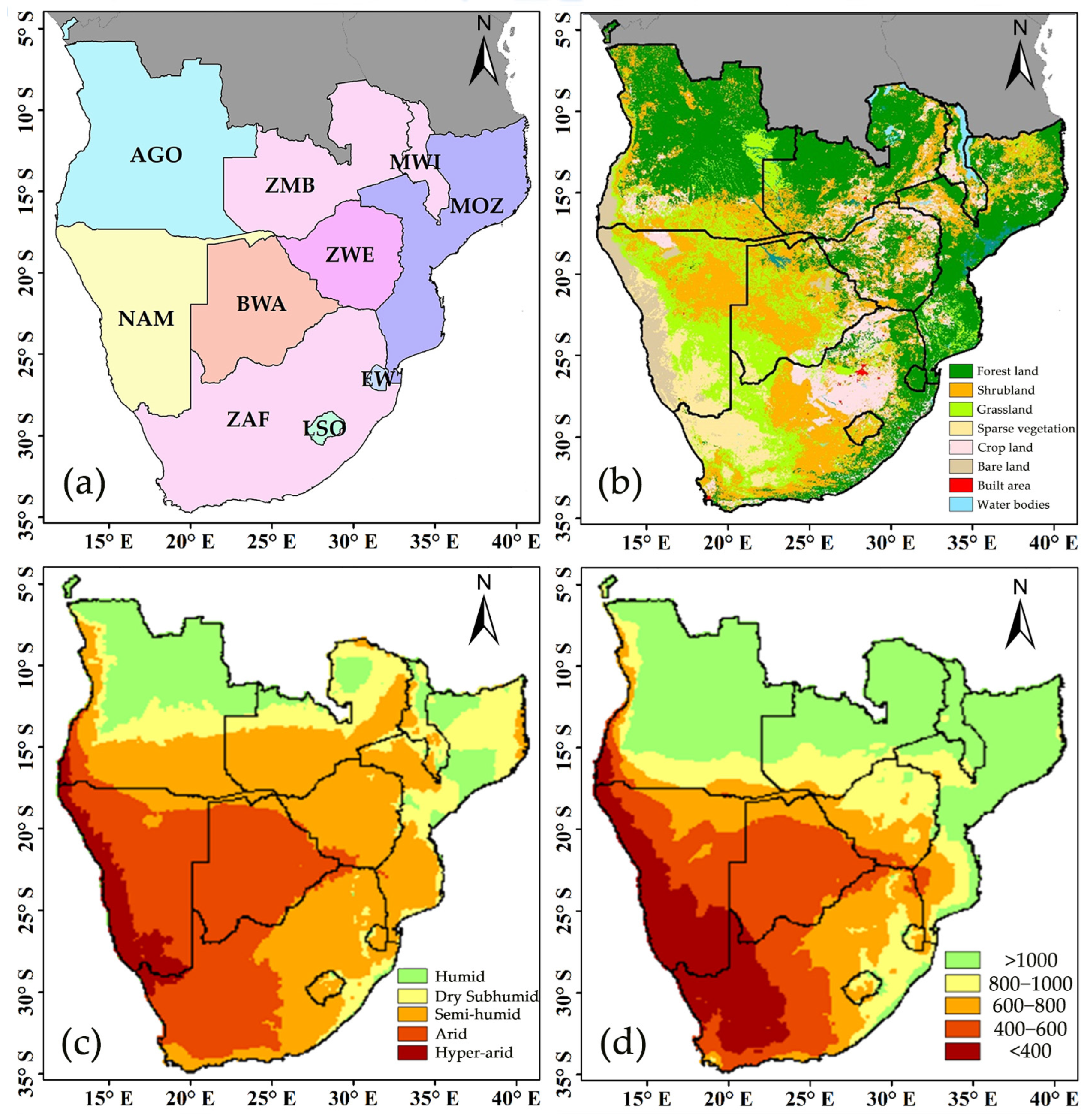
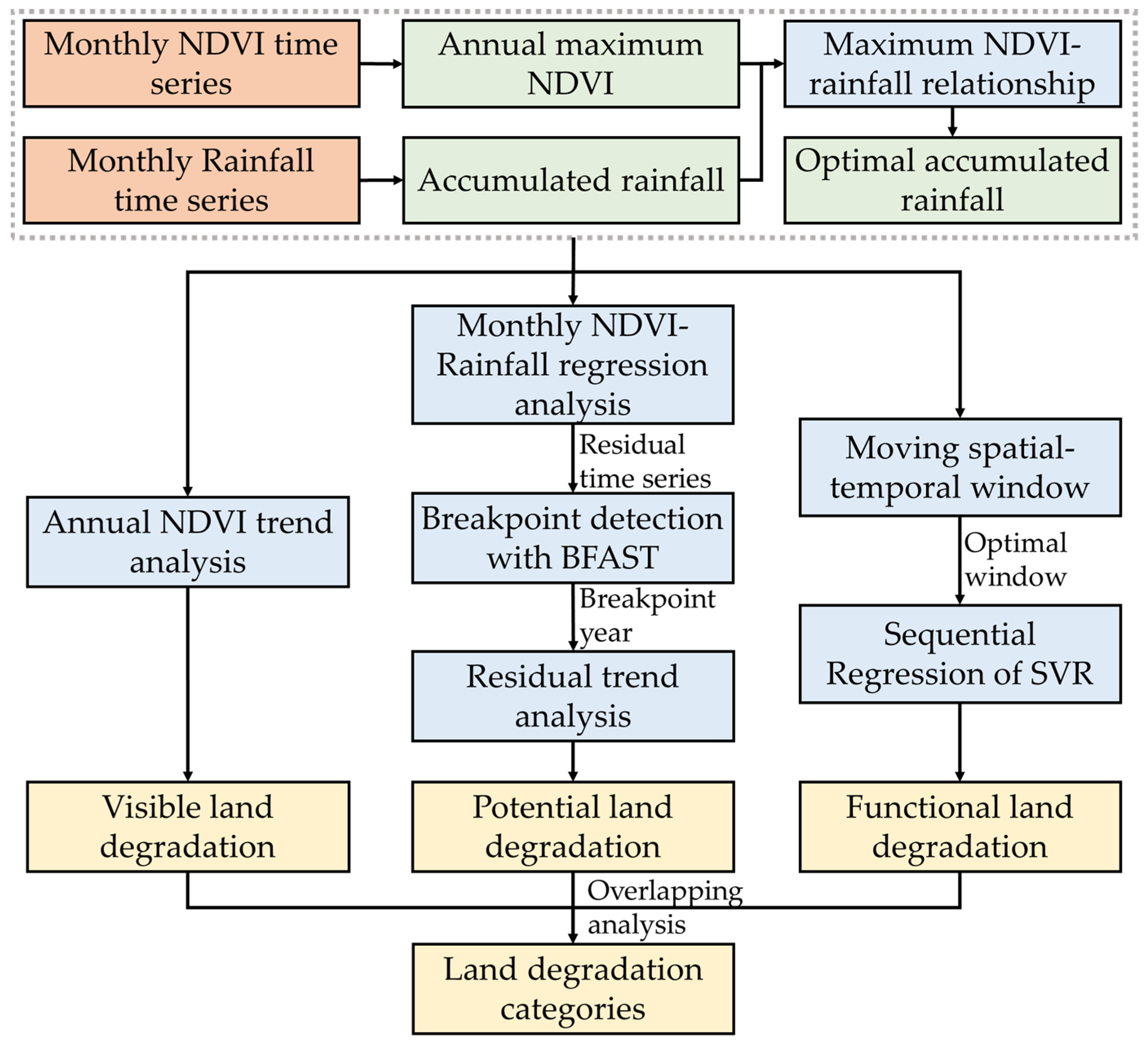
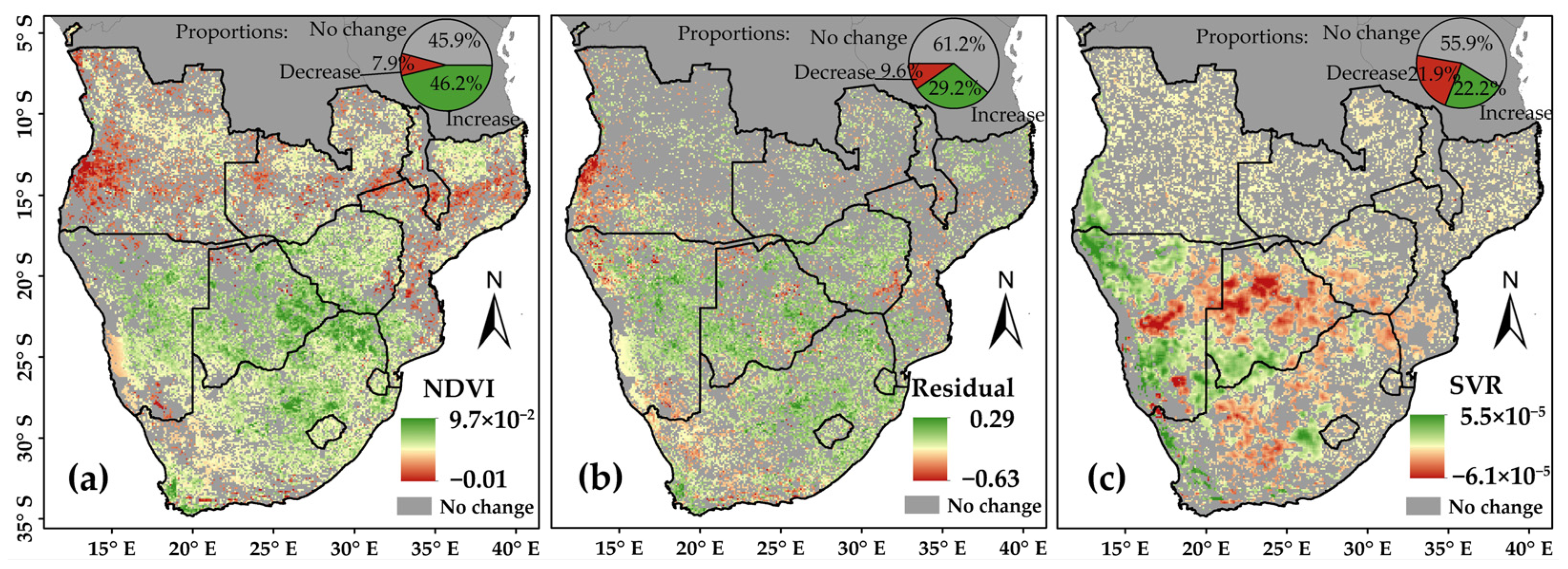
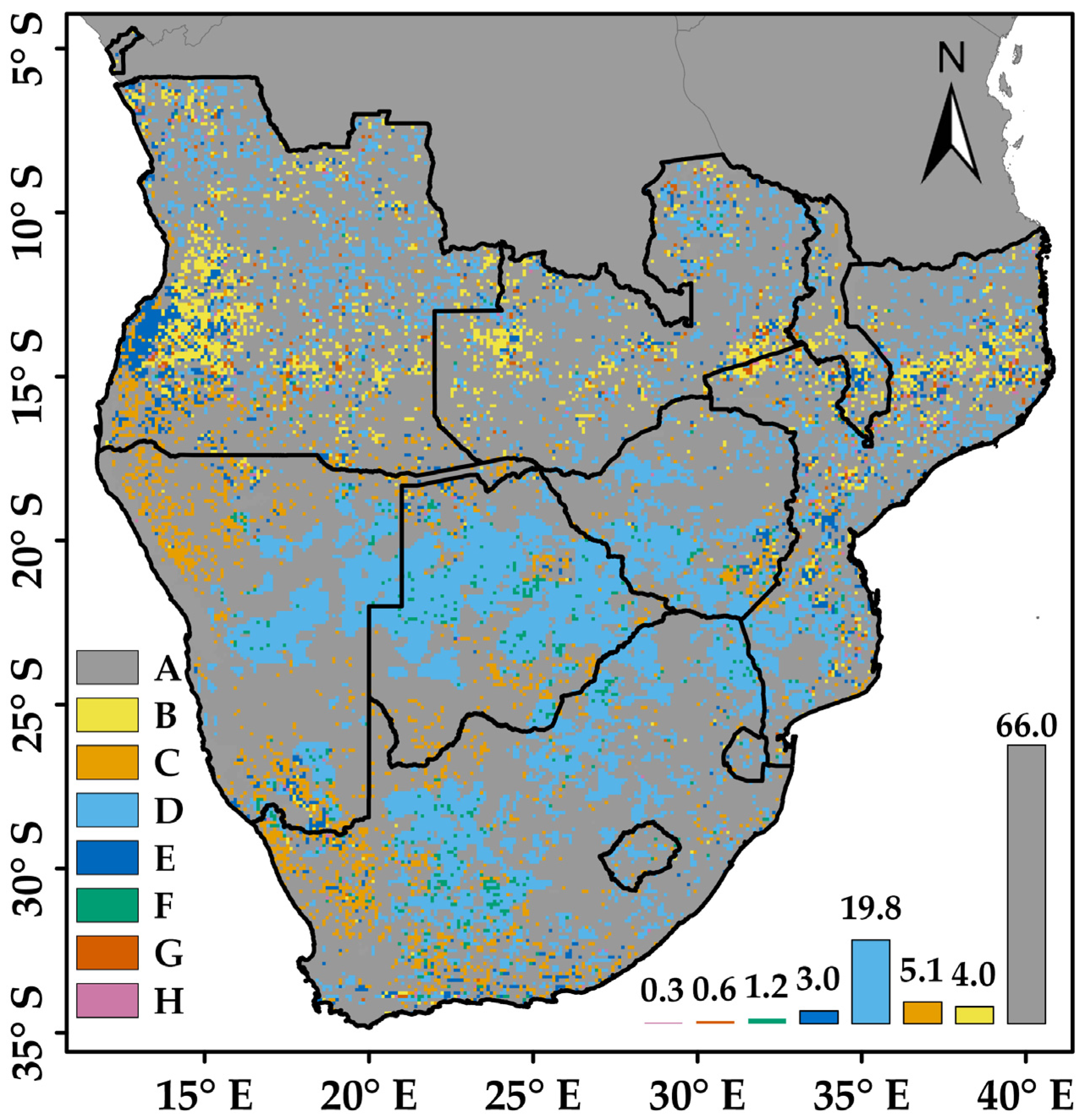
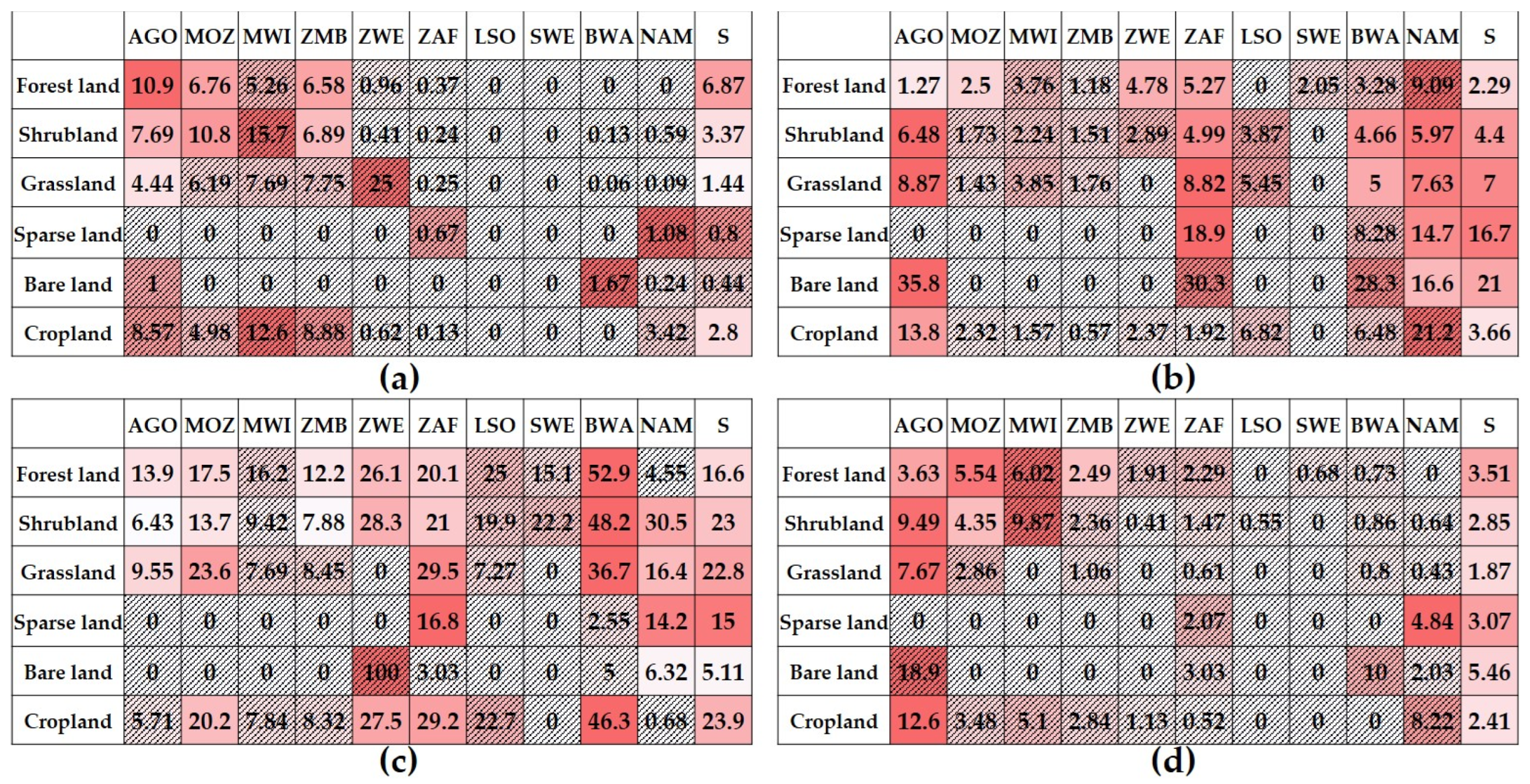
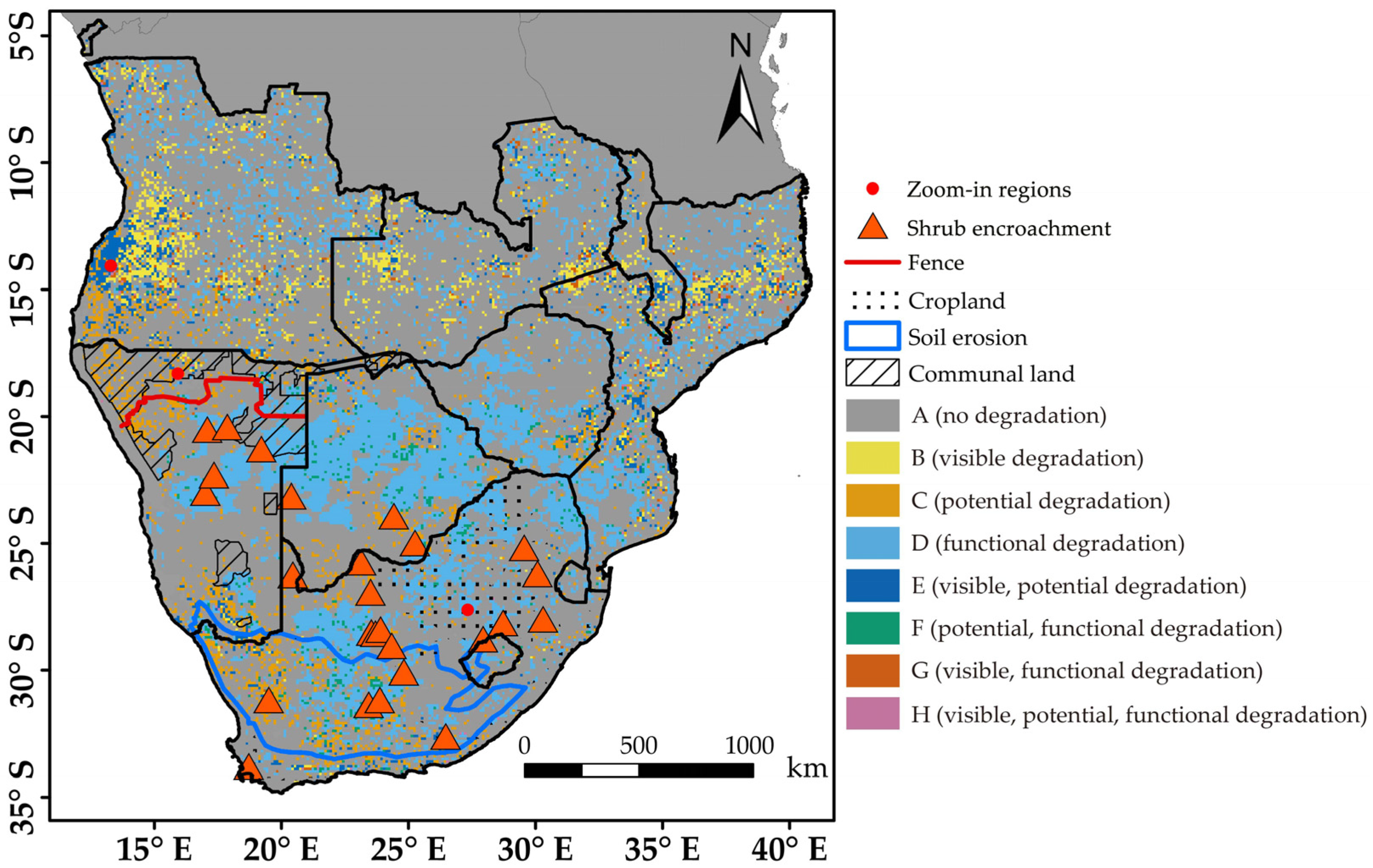
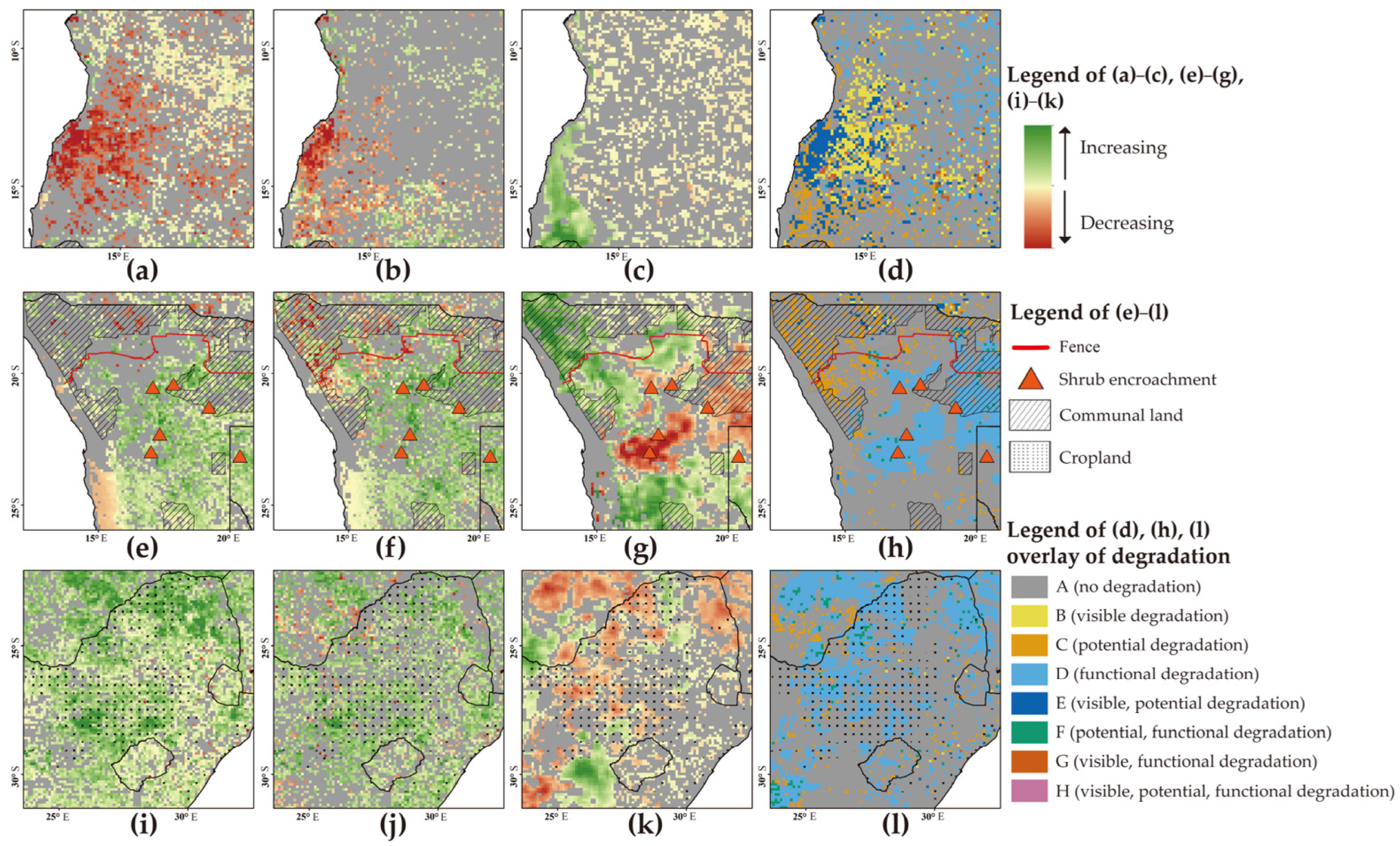
 |
 |
| Land Cover | A | B | C | D | E | F | G | H |
|---|---|---|---|---|---|---|---|---|
| Forest land | 68.58 | 6.87 | 2.29 | 16.55 | 3.51 | 0.62 | 1.03 | 0.54 |
| Shrubland | 64.18 | 3.37 | 4.40 | 22.95 | 2.85 | 1.41 | 0.55 | 0.30 |
| Grassland | 64.56 | 1.44 | 7.00 | 22.81 | 1.87 | 2.04 | 0.18 | 0.10 |
| Sparse vegetation | 61.32 | 0.80 | 16.67 | 15.01 | 3.07 | 2.70 | 0.07 | 0.37 |
| Bare land | 67.61 | 0.44 | 20.95 | 5.11 | 5.46 | 0.35 | 0.00 | 0.09 |
| Cropland | 65.85 | 2.80 | 3.66 | 23.85 | 2.41 | 0.76 | 0.51 | 0.18 |
| Systems | Drivers | Processes | Classification of Degradation | Source |
|---|---|---|---|---|
| Forest degradation | Increasing demand for timber | Timber extraction | visible degradation and potential degradation | [48] |
| Deforestation | Increasing demand for timber and food | Forest converted to cropland | visible degradation | [11,48] |
| Shrub encroachment | Increasing temperature, concentration of CO2, fire | Grass replaced by shrubs and woody plants | functional degradation | [49] |
| Overgrazing | Increasing demand for food, communal land, fence | Decreasing production of forage | potential degradation | UNCCD in Namibia [50] |
| Soil erosion | Heavy rainfall, decreasing vegetation cover | Soil degradation | potential degradation, functional degradation | [14] |
| Intensified agriculture | Increasing demands for food | Shortened rotation (impoverishment), irrigation (salination), soil erosion | functional degradation | [48,51] |
Disclaimer/Publisher’s Note: The statements, opinions and data contained in all publications are solely those of the individual author(s) and contributor(s) and not of MDPI and/or the editor(s). MDPI and/or the editor(s) disclaim responsibility for any injury to people or property resulting from any ideas, methods, instructions or products referred to in the content. |
© 2023 by the authors. Licensee MDPI, Basel, Switzerland. This article is an open access article distributed under the terms and conditions of the Creative Commons Attribution (CC BY) license (https://creativecommons.org/licenses/by/4.0/).
Share and Cite
Li, Z.; Li, C.; Gao, D.; Wang, S. Discrimination among Climate, Human Activities, and Ecosystem Functional-Induced Land Degradation in Southern Africa. Remote Sens. 2023, 15, 403. https://doi.org/10.3390/rs15020403
Li Z, Li C, Gao D, Wang S. Discrimination among Climate, Human Activities, and Ecosystem Functional-Induced Land Degradation in Southern Africa. Remote Sensing. 2023; 15(2):403. https://doi.org/10.3390/rs15020403
Chicago/Turabian StyleLi, Zidong, Changjia Li, Dexin Gao, and Shuai Wang. 2023. "Discrimination among Climate, Human Activities, and Ecosystem Functional-Induced Land Degradation in Southern Africa" Remote Sensing 15, no. 2: 403. https://doi.org/10.3390/rs15020403
APA StyleLi, Z., Li, C., Gao, D., & Wang, S. (2023). Discrimination among Climate, Human Activities, and Ecosystem Functional-Induced Land Degradation in Southern Africa. Remote Sensing, 15(2), 403. https://doi.org/10.3390/rs15020403








